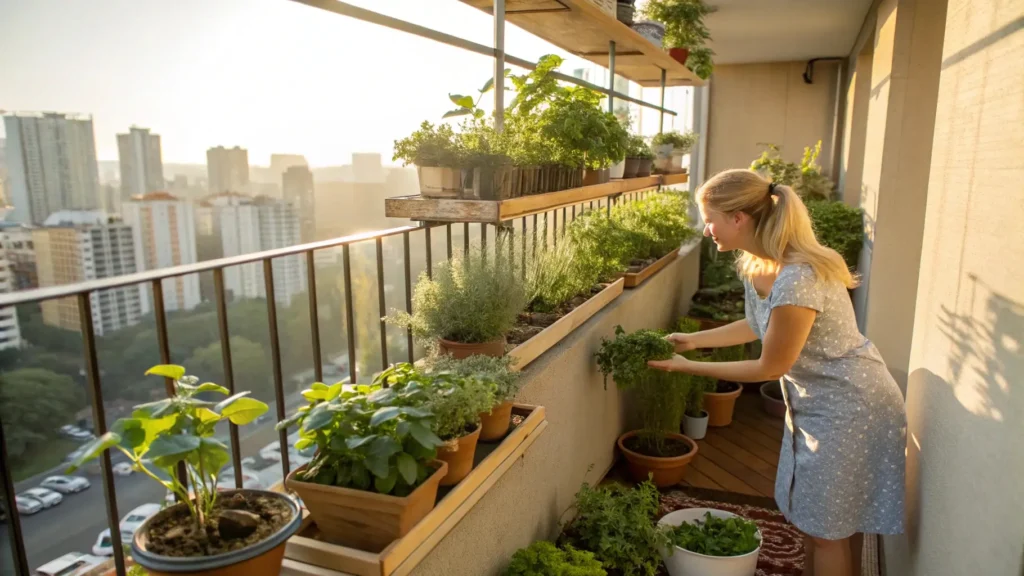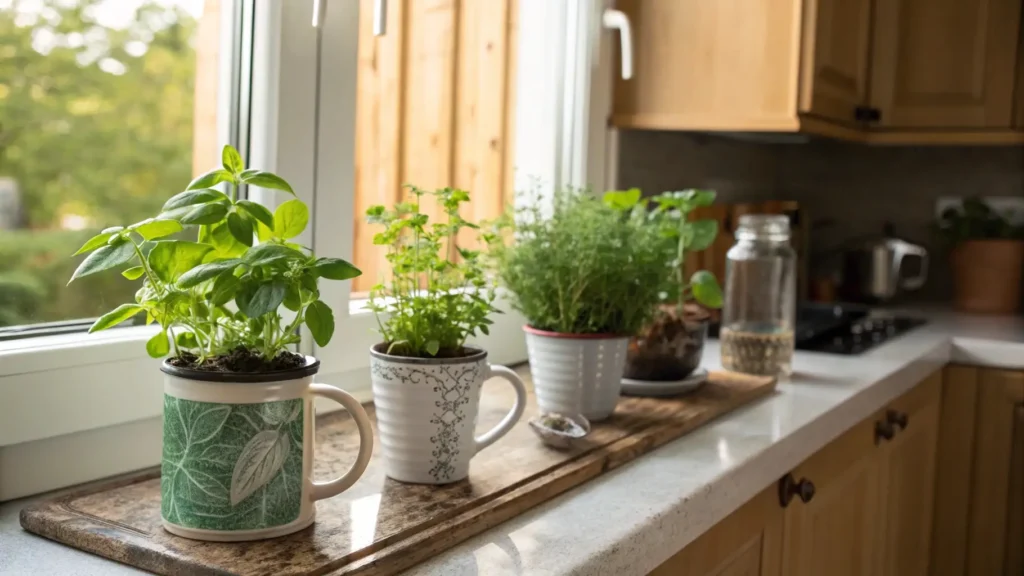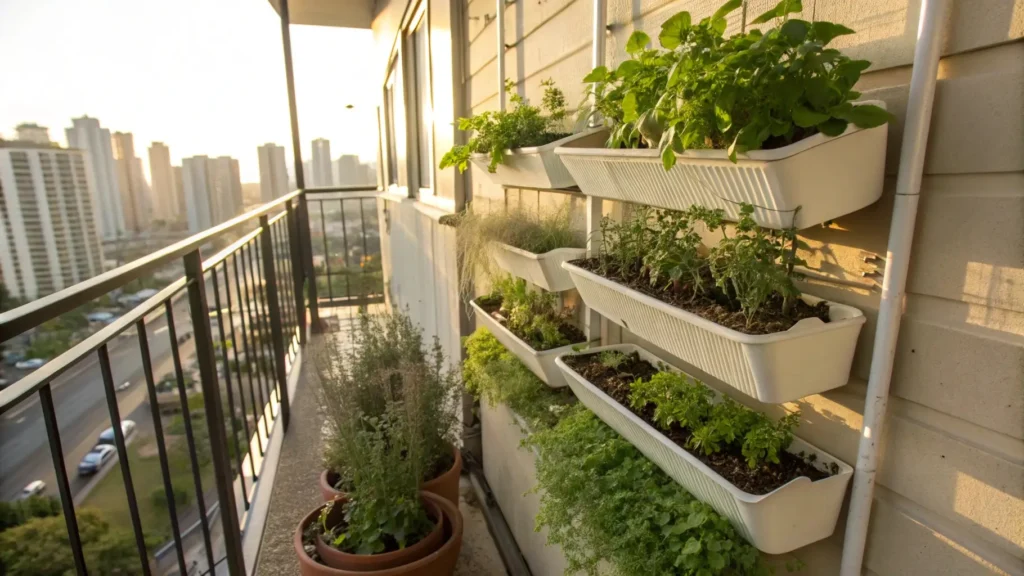Ever look at your tiny balcony or window ledge and think, “Yeah… nothing green’s surviving out there”?
Same.
But here’s the truth: you don’t need a backyard or a green thumb to start an urban garden. In fact, some of the most thriving mini-jungles are growing in high-rise apartments, fire escapes, and recycled yogurt containers. Wild, right?
Whether you’re dreaming of fresh herbs for dinner or just want something leafy to stare at while doomscrolling, small space gardening is more doable (and more fun) than it looks.
You’ll be surprised what a few pots, a sunny spot, and a little know-how can do — even if your past plants have all met, um… tragic ends.
So grab your coffee (or compost tea, if you’re already fancy) — we’re about to break down the basics of container gardening, help you find the perfect spot in your city cave, and show you how to get started without a yard, a budget, or a clue.
Ready to green up your space? Let’s dig in.
Table of Contents
Starting an Urban Garden (When You Have Zero Space and Less Hope)
You don’t need a backyard, a garden shed, or even a full balcony to grow something green. Urban gardening is all about making space where there is none — and turning it into something alive.
Let’s break it down.

1. Urban gardening works anywhere — even in tiny spaces
City living doesn’t have to mean a plant-free life. Whether you’ve got a windowsill, a corner near the heater, or a skinny little balcony that barely fits a chair, you’ve got enough room to grow something.
The trick? Think small and smart.
- A pot of basil in the kitchen.
- A few salad greens on a shelf by the window.
- A tomato plant in a deep bucket on your fire escape.

Small space gardening isn’t about doing everything — it’s about doing something with what you have. And once you start, it’s kind of addictive.
2. You don’t need fancy tools to start
There’s this idea that gardening means expensive gear, a greenhouse, or at least a dozen Pinterest-perfect planters. Nope.
All you really need is:
- A container (clean yogurt tub? Old crate? That works)
- Some decent potting soil
- A plant or seed that matches your light situation
That’s it. No raised beds. No perfect setup. Just start small, make mistakes, and learn as you go — because that’s how every urban gardener begins.
Best Plants for Urban Gardens That Won’t Ghost You
Not all plants are built for city life — and some will absolutely ghost you the minute you miss a watering. If you’re just starting out, go with the chill ones. The ones that don’t throw a fit if you forget them for a day. Or two.
1. Start with herbs and leafy greens

They’re the MVPs of small space gardening: compact, fast-growing, and useful. Plus, they don’t need deep soil or full sun all day long.
Here are a few that actually like small pots:
- Basil — great in sun, perfect for beginners
- Mint — nearly impossible to kill (just don’t plant it with anything else)
- Lettuce or arugula — grows fast and doesn’t ask for much
Perfect for balconies, windowsills, or even the kitchen counter.
2. Skip the high-maintenance drama queens
Some plants are just too much — space-hogging, high-maintenance, or straight-up difficult in containers. Unless you’re in for a challenge (or heartbreak), avoid things like:
- Cucumbers or pumpkins — they sprawl like they own the place
- Corn — yep, it looks cool… but not in a planter box
Keep it simple. Pick plants that are cool with less space and a little neglect. Your future self will thank you.
How to Keep Your Urban Garden Alive Without Losing Your Mind
So, your plants are finally in place — looking cute, maybe even thriving. But now comes the real game: keeping them alive. Don’t worry, this part doesn’t require a botany degree or a crystal ball.
1. Water smart — not too much, not too little
This is where most beginners mess up. Too much water? Roots drown. Not enough? Your plant wilts like a forgotten salad.
Here’s the move:
- Stick your finger in the soil. If the top inch is dry, it’s watering time.
- When you do water, go deep. Let it soak through — no lazy sprinkles.
Bonus: Most herbs and greens prefer being a little dry over being constantly soaked. So if in doubt, wait.
2. Sunlight isn’t optional — track it
Plants need light like we need coffee. But not all light is created equal.
- South-facing windows or balconies = goldmine.
- East/west-facing? Still good.
- North-facing? Stick to low-light plants or get a grow light.
Before you plant anything, watch your space for a full day. Morning to evening. Know where the sun actually hits — and plan your mini garden around it.
Level-Up Urban Gardening (Vertical, Compost, and Other Cool Stuff)
Once your basic setup is rolling, it’s hard not to start thinking, “Okay… what’s next?” Good news — urban gardening has layers. Literally.
1. Go vertical when space runs out

No more floor space? Look up.
Vertical gardening turns bare walls, railings, or corners into plant towers. Use:
- Wall planters, stacked shelves, or even hanging shoe organizers
- A mix of herbs, salad greens, and trailing plants — it’s functional and looks good
It’s the fastest way to double (or triple) your grow zone without needing more square footage.
2. Try composting — yes, even in an apartment
Think compost is only for people with yards and chickens? Think again.
Small-space composting is a thing. And it works.
- Bokashi bins or vermicomposters fit under sinks or in closets
- They break down your kitchen scraps and turn them into rich soil food
No stink, no mess — just less waste and better soil. And honestly? Turning trash into garden gold feels pretty great.
Ready to Grow Something Real?
Urban gardening isn’t about having the perfect setup. It’s about doing what you can, with what you’ve got — a bit of light, a few containers, and the patience to watch things grow (even if they start a little wonky).
Whether you’re nurturing a basil plant on your windowsill or planning a full vertical garden on your balcony, what matters is that you start. The rest? You’ll figure it out as you go — just like every other city gardener.
And trust me, there’s nothing like picking your first homegrown herb, leaf, or cherry tomato and thinking, “Wait, I actually grew this?”
Yep. You did.
Now go grab some pots, chase the sunlight, and give your space a little life.
Your garden is waiting — no yard required.
FAQ:
Can I start an urban garden if I don’t have a balcony?
Absolutely. A sunny windowsill, a shelf near a window, or even a well-lit corner in your kitchen can work. Urban gardening is all about adapting to your space — no balcony required.
What are the easiest plants to grow indoors?
Start with herbs like basil, mint, or parsley. Leafy greens like arugula and lettuce also do well in small containers and low-maintenance setups.
Do I need special soil for a balcony or container garden?
Yes. Use potting mix instead of regular garden soil — it’s lighter, drains better, and helps roots breathe. You can boost it with compost or organic fertilizer if needed.
How much sunlight do my plants need?
Most edible plants need 4 to 6 hours of sunlight daily. South-facing windows or balconies are ideal. If your space is shady, choose low-light plants or use a small grow light.
What if I forget to water my plants?
It happens. Pick drought-tolerant plants like mint or succulents, and use deep watering techniques — it helps plants last longer between waterings. You can also add a simple self-watering system.




